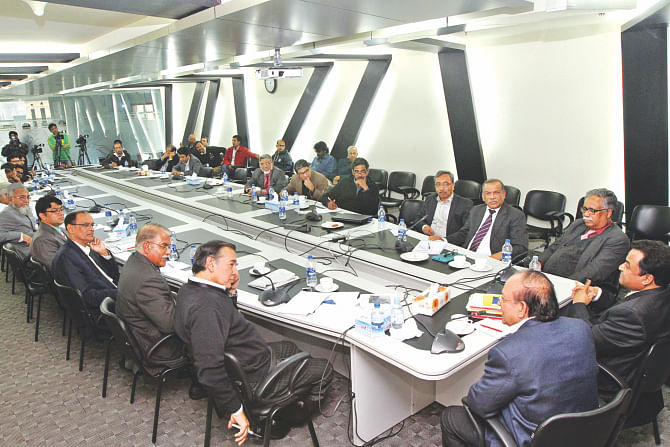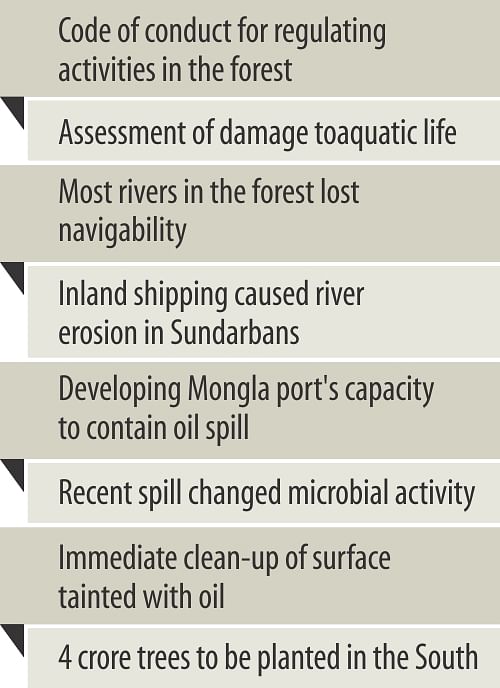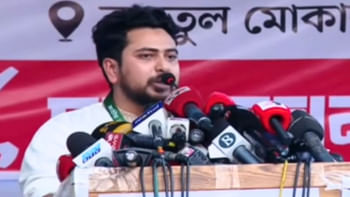No compromise on Sundarbans' safety

Development of the southwestern region should be done without causing any harm to the biodiversity of the Sundarbans and no commercial navigation route should cut through the mangrove forest, said panellists at a roundtable yesterday.
They suggested that the government should design a comprehensive plan to protect the forest and put in place a mechanism to monitor the long-term impact of all kinds of development activities in the region.
In response, Planning Minister AHM Mustafa Kamal assured that environmental risks would be taken into consideration before the implementation of any development project in the area.
As his attention was drawn to the Rampal coal-based power plant to be built about 14km from the forest, he said, "Cargo vessels would travel from Paira seaport to the plant and won't touch the Sundarbans."
Speaking at the roundtable on “Development of Southwestern Region and Protecting the Sundarbans” at The Daily Star Centre, the minister also said both the power plant and Paira seaport would come into operation simultaneously.
Referring to the recent oil spill in the Shela River crisscrossing the Sundarbans, Prof Ainun Nishat, of Brac University, said, the authorities concerned should always be prepared to handle such a disaster and that local community's participation in the effort must be ensured.

The forest research institute or the forest department should take up a long-term programme to design a mechanism to monitor the impacts of such disasters on the Sundarbans, he added.
About the location of Mongla Port, Nishat said the port was located at a place where ships had to go through the Pashur river, one of the major rivers that pass through the mangrove forest.
The port has no future because of its siltation problem, he said, adding that it should have been built in the south of the Mongla channel at Joymongol or Baniashanta.
He also suggested shredding off and burning the floors of the forest, which came in contact with the oil of the sunken tanker before it spread further in tidal waves.
Khabirul Haque Chowdhury, a teacher of Bangladesh University of Engineering and Technology, did not want to call the sinking of an oil-laden tanker on December 9 an accident.
"We term tankers as mobile bombs.”
As an IMO (International Maritime Organisation) signatory country, the government committed itself to ensuring that the ships that transport fuel must have double bottoms and double hulls, Khabirul said.

The vessel would not have sunk in the Shela river if it had a double hull and double bottom. It did not seem to be a tanker, he said, rather it appeared that it carried fuel with the licence of a cargo vessel, meaning there was no monitoring whatsoever.
He also said the dredging system was plagued with rampant looting.
Wildlife expert Reza Khan said the country has around 1,100 species of wildlife and one third of it lives in the Sundarbans.
The extent of the damage caused by the oil spill is yet to be assessed, he said, but it surely had impacts on the edge of the forest affected by it and the wildlife living there and would continue to do so until the oil substance was completely removed.
"We must assess the degree of the damage done by this spillage and what would be its effect in the coming five to ten years.”
The assessment can be done by examining how much phytoplankton and zooplankton remain in the water of the affected area and compare it to other controlled areas of the Sundarbans, Reza said.
"We must have the capacity to contain such an accident by applying simple technologies like using boom to control oil slicks at the initial stage. We did not even have it in place. I hope this measure will be taken in future," he said.
On the Rampal power plant, he said a neutral body must be appointed to assess whether the project would pose any risk to the Sundarbans.

Chief Conservator of Bangladesh Forest Department Yunus Ali claimed that furnace oil slicks had spread over 300-350 square kilometres of the forest and affected mostly the small canals.
"The seedlings of Sundari, Gawa and Bain, whose heights are below one metre, may suffer," he said, citing a possible change in the microbial activity on the forest bed due to the spill.
Yunus Ali said most of the rivers inside the Sundarbans had lost their navigation, thanks to the withdrawal of water from Farakka and building polders to resist the intrusion of saline water.
In a study, he said, the forest department had found that all water vessels, irrespective of their fitness and engine condition, spilled oil a bit.
Despite objections from the department, shipping through the Sundarbans began in 2011, causing river erosion.
Referring to the 1927 forest act, Syeda Rizwana Hasan, executive director of Bangladesh Environmental Lawyers Association, said the duty of the forest department was still limited to collecting revenue and controlling transfer of forest resources.
The law does not oblige the department to protect and preserve the natural forests.
Environment and Forest Minister Anwar Hossain Manju said the forest department should not be held responsible for the incident.
Without mentioning any name, he said another ministry that was responsible had not dealt with the disaster promptly.
"They should have rushed to the scene immediately.”
Manju continued that his ministry would comply with the recommendations to be made by the UN mission that visited the accident site and would plant four crore saplings with the help of navy in the coastal areas of the southwestern region.
Zoology professors Monirul Khan and Anwarul Islam of Jahangirnagar University and Dhaka University spoke of the economic importance of the Sundarbans in terms of revenue generation and dependency of the local community on the aquatic eco-system of the region.
Sheikh Md Abdul Rashid, chief executive of the Center for Advanced Research in Natural Resources and Management, called for an assessment of the long-term environmental impact of the oil spill.
Md Abdul Matin, general secretary of Bangladesh Paribesh Andolon, said a code of conduct should be developed for visitors to the Sundarbans.
Eftekharul Alam, an environmental consultant for the World Bank, spoke of concerns raised by the excessive use of groundwater and an increase in underground salinity in the southwestern region, and the need to recharge groundwater.
"We only take from nature. But we also have to preserve it and work for its development," said Prof MA Jalil of Buet.
Demanding an end to all kinds of navigation through the Sundarbans, he said, an alternative route had to be created at any cost.
Columnist Syed Abul Maksud suggested another round of discussion after the UN mission submits its report.
Presenting the geo-morphological situations of the rivers of the region, Maminul Haque Sarker, deputy executive director of the Center for Environmental and Geographical Information Service, said both embankments and shrimp farming affected the rivers and caused siltation on the Mongla-Goshaikhal route.
Mahfuz Anam, editor and publisher of The Daily Star, hoped that the recent accident would be a turning point and a wake-up call.
"Development of Bangladesh is needed and must be done. But at the same time, we need to think about protecting the Sundarbans to protect Bangladesh."
In conclusion, Planning Minister Mustafa Kamal shared government's plan for the development of the region, where inland migration is causing a decline in the population.
The government plans to establish trade centres in the districts to encourage more people from that region to go abroad for earning, and to develop township, small and medium industries and industrial zones once the Padma Bridge is completed.
Mentioning that saline water ruined 26 percent of the land, the minister said the government had a plan to build a barrage at Pangsa in Rajbari at Tk 31,413 crore. Many problems, including salinity, will be addressed once this barrage is built, he added.

 For all latest news, follow The Daily Star's Google News channel.
For all latest news, follow The Daily Star's Google News channel. 



Comments